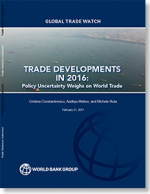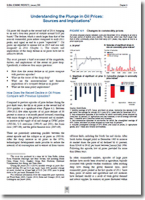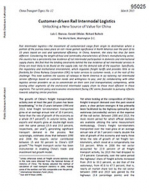Trade Developments in 2016
In this report, the authors addresses three questions concerning recent trade developments: what is happening?; why?; and does it matter? The report is organized into 2 chapters: chapter one presents trade developments in 2016; and chapter two presents trade and productivity slowdowns: the role of global value chains.
2016 is the fifth consecutive year of sluggish trade growth and the year with the weakest trade performance since the aftermath of the 2008 global financial crisis.
Current estimates of growth in the volumes of trade in goods and services range from 1.9 percent to 2.5 percent; preliminary high-frequency data suggest that merchandise trade volumes may have grown by slightly above 1 percent.
The year 2016 is different from the other post crisis years, in that trade sluggishness is a characteristic of both advanced and emerging economies.
Trade developments in 2016 continued to reflect enduring structural determinants, such as the maturing of global value chains (GVCs) and the slower pace of trade liberalization, as well as cyclical factors, notably slow global growth, the trough in commodity prices, and macroeconomic rebalancing in China.
The increase in policy uncertainty may account for up to 75 percent of the worsening of the trade slowdown in 2016.
What Is Happening?
2016 is the fifth consecutive year of sluggish trade growth and the year with the weakest trade performance since the aftermath of the 2008 global financial crisis.
Current estimates of growth in the volumes of trade in goods and services range from 1.9 percent to 2.5 percent, but preliminary high-frequency data suggest that merchandise trade volumes may have grown by only about 1 percent.
The year 2016 is different from the other post crisis years, in that trade sluggishness is a characteristic of both advanced and emerging economies.
Since 2008, trade values of services and trade values of goods have followed different trajectories, with growth in services trade more resilient during the global financial crisis and the global trade slowdown of recent years.
Why?
Trade developments in 2016 continued to reflect enduring structural determinants, such as the maturing of global value chains (GVCs) and the slower pace of trade liberalization, and cyclical factors, notably slow global growth, the trough in commodity prices, and macroeconomic rebalancing in China.
Does It Matter?
The trade slowdown, insofar as it is attributable to the stagnation of GVCs, may also help to explain part of the recent productivity slowdown.
The slower pace of GVC expansion could be diminishing the scope of productivity growth through a more efficient international division of labor and diffusion of technologies.
Analysis of manufacturing data according to country and year reveals a link between labor productivity and GVCs. The data point to a positive association between growth in real labor productivity per employee in manufacturing and growth in vertical specialization.
A formal econometric analysis based on a panel estimation covering 13 sectors in 40 countries over 15 years suggests that participation in GVCs is a significant driver of labor productivity.
An increase of 10 percent in the level of GVC participation increased average productivity by 1.7 percent.
What’s Related




Favorites





